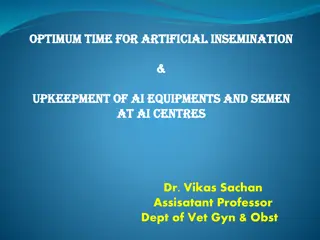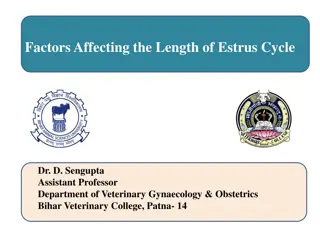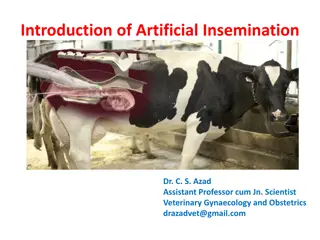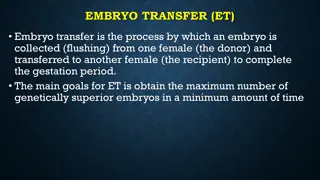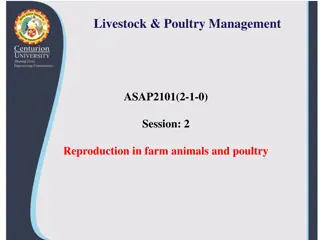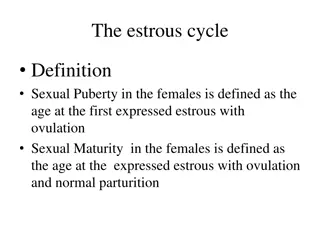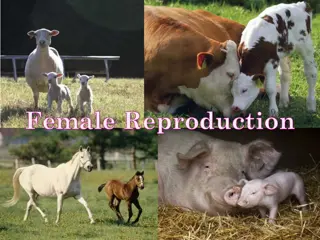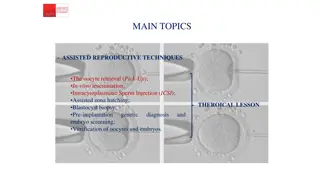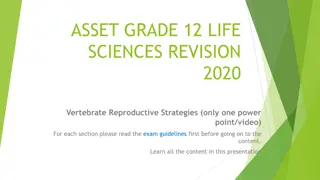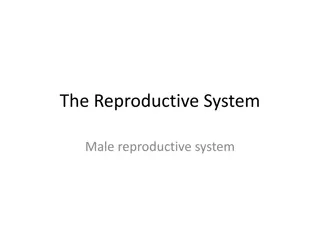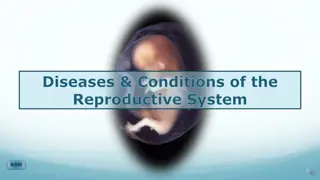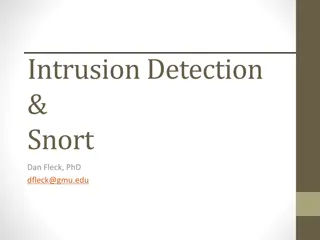Reproductive Management in Animals: From Estrus Detection to Artificial Insemination
Explore the key concepts of estrus detection, natural and artificial insemination, estrous cycle timing, and methods for detecting estrus in animals. Understand the importance of these processes in managing animal reproduction effectively.
Download Presentation

Please find below an Image/Link to download the presentation.
The content on the website is provided AS IS for your information and personal use only. It may not be sold, licensed, or shared on other websites without obtaining consent from the author. Download presentation by click this link. If you encounter any issues during the download, it is possible that the publisher has removed the file from their server.
E N D
Presentation Transcript
ESTRUS DETECTION AND ARTIFICIAL INSEMINATION
NATURAL INSEMINATION Deposition of semen by a male into the reproductive tract of a receptive female under normal body conditions and environment
ARTIFICIAL INSEMINATION The deliberate introduction of semen into a female for the purpose of fertilization, by means other than ejaculation directly into the vagina or oviduct.
ESTRUS The period where the female is receptive to the male, will stand for mating, and is capable of conceiving
CAPACITATION The change undergone by sperm in the female reproductive tract that enables them to penetrate and fertilize an egg
ESTROUS CYCLE The reproductive cycle of domestic animals. It is measured from the beginning of one estrus to the beginning of the next.
TIMING OF EVENTS IN THE REPRODUCTIVE CYCLE Species Species Length of Estrous Length of Estrous Cycle Cycle Duration of Estrus Duration of Estrus Time of ovulation Time of ovulation Ewe 17 days 24-36 hours 24-30 hours from onset of estrus Goat 21 days 32-40 hours 30-36 hours from onset of estrus Sow 21 days 48-72 hours 35-45 hours from onset of estrus Cow 21 days 18-19 hours 10-11 hours after the end of estrus Mare 21 days 4-8 days 1-2 days before the end of estrus
METHODS OF ESTRUS DETECTION Visual inspection 30 minutes morning and evening Standing to be mounted Mounting other animals Swollen vulva Mucus Swollen Vulva Swollen Vulva Mucus Mucus
METHODS OF ESTRUS DETECTION Teaser animals Surgically altered Vasectomized Gomer bull Androgenized cows or steers
METHODS OF ESTRUS DETECTION Marker Aids Chinball marker Heat-Mount detectors (i.e. K-Mar patches) Chalk or paint tail head
CONSIDERATIONS OF ESTRUS DETECTION Cost Time and Labor Ability of male to achieve intromission Proper Heat Detection is Critical Proper Heat Detection is Critical
ARTIFICIAL INSEMINATION
HISTORY 1780- First successful AI in dog - Italy 1900- Use of AI in horses - Russia 1938- First AI co-op for bull semen in US - Rutgers University 1948- 3% of dairy cows bred by AI in the US 1957- American Breeder Service began to use liquid nitrogen to freeze semen and store it in glass ampules
HISTORY CONTD. 1972 AI organization began using plastic straws for storing semen. Smaller in size for more efficient storage and less volume. Easier to thaw and control temperature. Increase thawing rate Increase surface area
ARTIFICIAL INSEMINATION ADVANTAGES DISADVANTAGES Genetic improvement through increased use of superior sires Disease control Improving record keeping Eliminates need for keeping bulls Time required to detect estrus Percent of cows in estrus during breeding season Trained personnel required Overuse of inferior bulls
MAJOR STEPS OF ARTIFICIAL INSEMINATION Collection of sperm for the male Preservation and extension of sperm Insemination of the female
COLLECTION OF SEMEN Artificial vagina Device that simulates vaginal conditions of a female in estrus Electro ejaculation Electrical stimulation of the accessory sex glands and pelvic urethra resulting in ejaculation.
DESIGN OF ARTIFICIAL VAGINA Provide a suitable environment for simulation of the glans penis Provide an environment that prevents damage to the penis Provide an environment that maximizes sperm recovery and minimizes sperm insult
ARTIFICIAL VAGINAS Consist of an outer casing fashioned of reinforced rubber and a liner that is usually rubber and can be lubricated Temperature and pressure are controlled by the water placed between the liner and the casing One end of the AV is attached to a funnel that is attached to a semen vessel
TYPES OF ARTIFICIAL VAGINAS Horse Horse - - Missouri Style Missouri Style Boar Boar Bull AV Bull AV Ram AV Ram AV Horse AV Horse AV- - Colorado Style Colorado Style
ELECTRO EJACULATION Generally used in males of high genetic value that cannot physically perform mounting and ejaculation.
PRESERVATION AND EXTENSION OF SPERM Immediately after collection, the following is needed: Ejaculate volume Concentration of spermatozoa in the ejaculate Percentage of motile sperm
EVALUATION OF SEMEN Total number of sperm in the ejaculate determines the number of insemination doses within each ejaculate. Good quality - 60% or more motile sperm Less than 50% motile sperm may be discarded especially if the sperm will be frozen
DETERMINING NUMBER OF DOSES Determination of doses for good quality sperm: Ejaculate volume: 6ml Sperm concentration: 1.0 x 109 sperm/ml (1 billion) Total sperm in ejaculate: 6ml x 1.0 x 109 sperm/ml = 6 x 109 (6 billion) Progressive motility: 70% Total motile sperm: 6.0 x 109 x 0.7= 4.2x 109 motile sperm/ejaculate Desired Concentration: 15 x 106 / dose (1 insemination) Number of doses: 4.2 x 109 / 15 x 106 = 280 doses
EXTENDERS Sperm must be preserved in order to inseminate females over a extended period of time. Extender - the solution in which spermatozoa are diluted extends the number of sperm and their functional life.
GOOD SEMINAL EXTENDERS MUST: Be isotonic Be good buffers Minimize cold damage Provide appropriate nutrients Prevent microbial growth Maintain viability Be relatively low in cost
HANDLING AND STORING SEMEN Improper handling and storing of semen may kill the sperm in the sample Each species of livestock has different criteria for handling and storing semen
SWINE LIQUID SEMEN Liquid semen should be maintained at 64 F for maximum fertility Maintains good fertility for 5 - 7 days at this temperature Re-evaluate semen if the temperature deviates from 50-80 F or is stored longer than 5 days Liquid semen comes ready to inseminate (no need to thaw)
FROZEN SEMEN Stored in a liquid Nitrogen tank Can be stored for long periods of time The level of liquid Nitrogen should never drop below four inches Frozen semen needs to be thawed immediately prior to use
RETRIEVING FROZEN SEMEN Quickly remove semen from canister to prevent damage Do no withdraw canister above the frost line If desired semen is not retrieved in a few seconds, lower the canister back into the liquid nitrogen for 30 seconds to cool completely Remove semen from the tank with forceps Keep semen out of direct sunlight ultraviolet light has a spermicidal effect. Note the location of the semen in the tank before removing plug from tank
THAWING FROZEN SWINE SEMEN Warm frozen extender to 68 F Remove one straw from the storage container and place in a 122 F water bath for 45 seconds. Do not hold the straw during this thaw period Remove the straw from water and dry thoroughly Hold straw vertically and snip off the upper tip Place sealed end over the open bottle of extender and snip to allow the semen to drain into the bottle Rinse the straw by aspirating extender into the straw
THAWING CATTLE SEMEN Place frozen semen in a 90 to 95 F water bath for at least 40 seconds Completely dry the semen straw after thawing Water is lethal to sperm Warm AI gun to avoid cold-shocking the semen. Cut semen straw at crimped end, not the end with the cotton plug. Place a plastic sheath over straw and gun
THAWING HORSE SEMEN Thaw semen in a 99 F water bath for 60 seconds Hold straw with long forceps and thaw in an upright position The air bubble in the center of the straw rising to the top indicates the semen is thawed Dry straw and cut off the ball end Cut other end of straw and allow semen to flow into the test tube. Attach an AI breeding pipette to a syringe and aspirate the semen
THAWING GOAT SEMEN (ICE WATER METHOD) Create an insulated ice water bath (38 - 42 F) Remove ampule from tank and place immediately into thaw box. Ampule should not come into direct contact with ice, place in a cup with holes Ampule may sit in ice water for as long as 30 minutes with no damage Use semen immediately upon removal from water The layer of ice on the ampule must be removed before opening to avoid possible contamination
THAWING GOAT SEMEN (WARM WATER METHOD) Create a warm water bath (92 to 98 F) Thawing will be completed in about 1 minute Ampules Should be used within 5 minutes
METHODS OF ARTIFICIAL INSEMINATION IN FEMALE
DEER AND GOAT Speculum- tube like instrument that spans vulva and posterior vagina allowing for visual inspection of os cervix
COW Rectocervical- manipulation of the cervix over the insemination gun via the rectum Utilize AM/PM rule for timing insemination
AM/PM RULE FOR CATTLE Universally accepted time for insemination Cows detected in estrus in the morning are bred that same afternoon, those found in estrus in the afternoon are bred the next morning
8 STEP PROCEDURE Thaw frozen semen slowly Place plastic glove over hand and arm. Lubricate plastic glove. Restrain animal Insert arm in animal s rectum Grasp the animal s cervix through the rectum Insert inseminating tube through the animal s vagina and into cervix. Deposit semen into animal s cervix.
COW AI VIDEO AI in cattle
SOW Introduce the spirette with a counter-clockwise rotation into the cervix Gilts - inseminate 12 hours after detection of estrus Sows - inseminate 24 hours after detection of estrus
SOW AI VIDEO Sow AI
MARE Vaginocervical - introduction of the insemination gun into the cervix via the vagina Insemination time is based on a presence of a 35mm follicle, open cervix, and detection of estrus
MARE AI VIDEO Mare AI
SHEEP Laparoscopy - surgical introduction of semen directly into the uterine horns
EWE AI VIDEO Ewe AI


